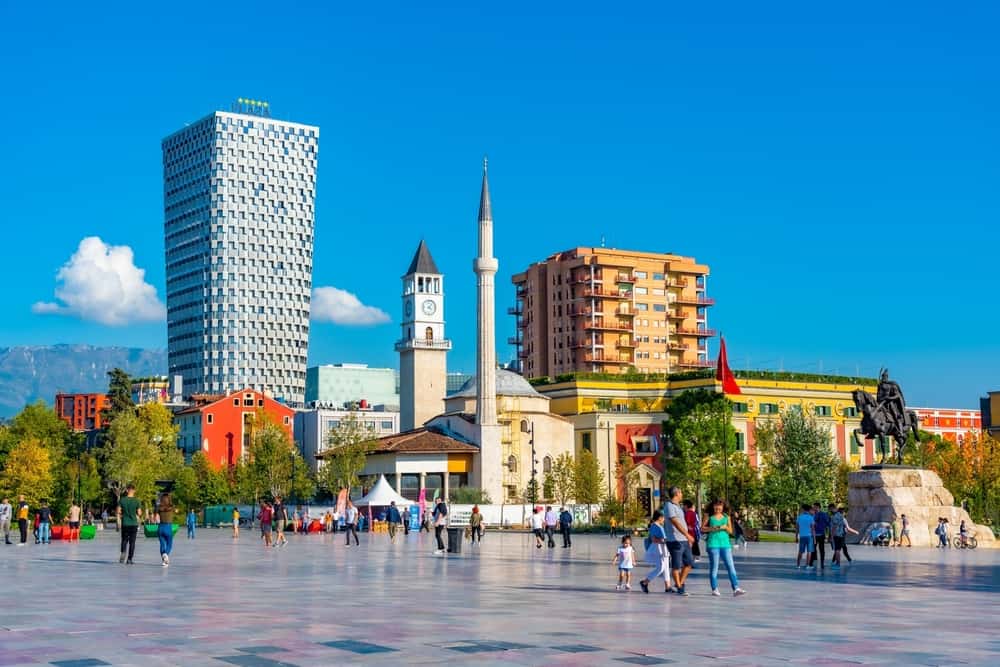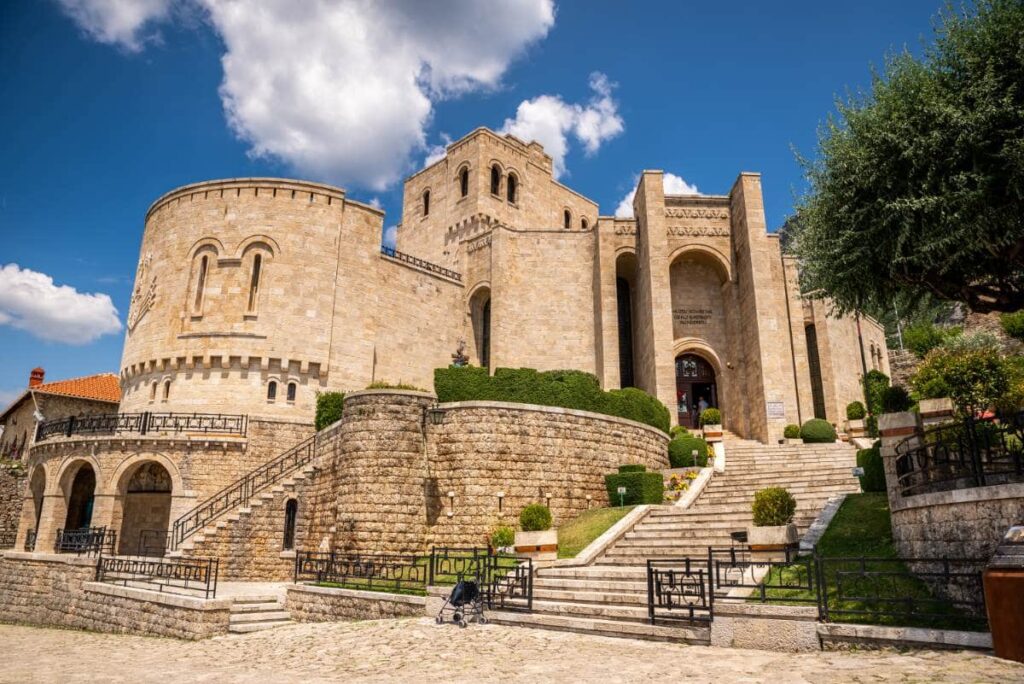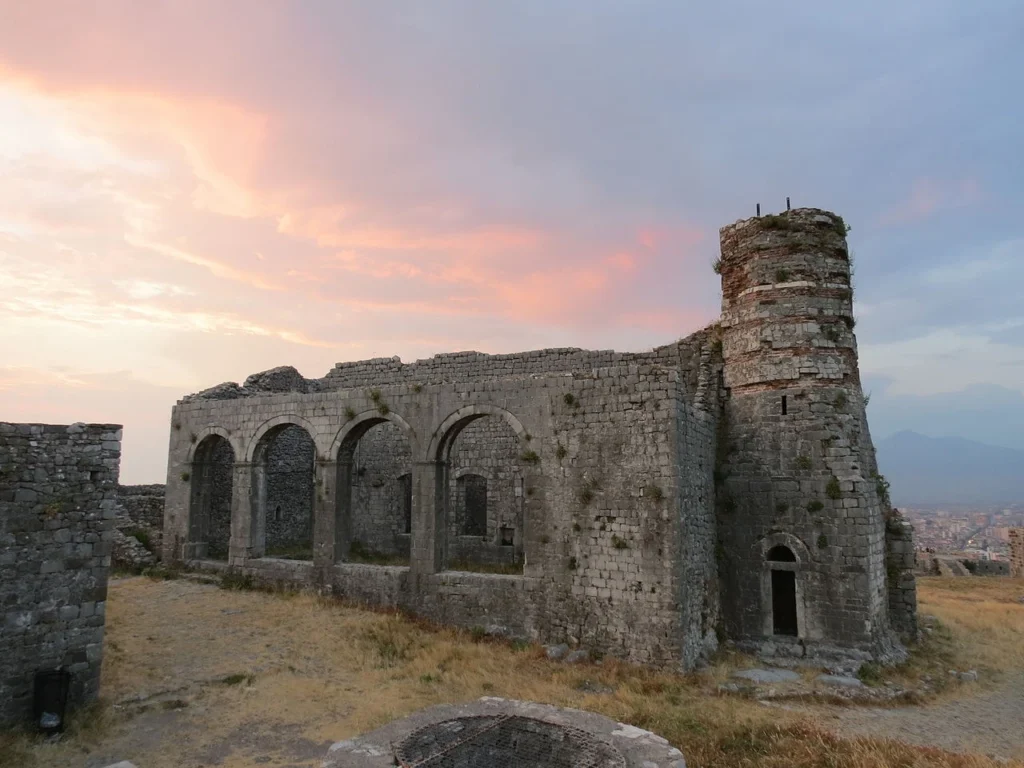WELCOME TO ALBANIA
Albania is a hidden gem in Europe with a wealth of tourist attractions, including stunning beaches, rugged mountains, ancient ruins, and vibrant cities. Its unique blend of history, culture, and natural beauty makes it a must-visit destination for any traveler seeking an off-the-beaten-path experience.
TIRANA
Tirana, the capital city of Albania, offers visitors a plethora of exciting experiences. From exploring the colorful mix of Ottoman, Fascist, and Communist-era architecture in the city center, to relaxing in the Grand Park or enjoying the buzzing nightlife scene. Visitors can discover the rich history of the National Museum, or take a day trip to the nearby Albanian Alps or the Albanian Riviera beaches. Tirana is a vibrant and authentic destination for any traveler seeking an unforgettable experience in Europe.

COASTAL TOURISM
Coastal tourism stretches from Shkodra to Sarande, with popular beaches including Velipoja, Shengjin, Durres, Golem, Mali i Robit, Spille, Seman, Vlora, Zverneci, Radhime, Orikum, Palasa, Dhermi, Jale, Himara, Qeparo, and Saranda. The region also includes islands such as Ksamil, Sazan, and Kunës, and notable capes like Rodon, Bishti i Palles, and Gjuheze. The Karaburun Peninsula, Albania's largest, features small bays and rocky beaches, including Gjiri i Grames and Gjiri i Brisianit. The thermal waters of Benjas near Permet offer a relaxing mountainous landscape.
PALASË
Palasa Beach is a long a wide beach west of the village of Palasa. It’s also the northernmost beach of the Albanian Riviera, just south of the Ceraunian Mountains. The surroundings are really beautiful with a skyline of mountains and the Llogara Pass on the mainland, and the Ionian Sea with it’s clear blue water on the other side.
dhËrmi
Near Drymades, you’ll find Dhërmi, one of the most famous places in Albania thanks to its poster lovely looks an expanse of pale pebbles and rocks lapped by turquoise waters. This beach is one of the longest on the Albanian Riviera in summer, it’s undoubtedly the busiest and loudest, with music playing through speakers and accommodation full to the brim. But if you’re prepared to walk a little, you should be able to find a spot for your own solitude, even in August.
DRYMADES
Looking west across the Adriatic Sea direction Southern Italy Drymades gets super fiery sunsets.
But that’s for later from the moment the day dawns it’s a stunner, with almost Maldivian blue waters caught in a small bay.
There is a pebbly stretch as well as a sandy expanse, the two divided by a large rock and things never get crowded, even during summer.
But that’s for later from the moment the day dawns it’s a stunner, with almost Maldivian blue waters caught in a small bay.
There is a pebbly stretch as well as a sandy expanse, the two divided by a large rock and things never get crowded, even during summer.
KSAMIL
When you first lay eyes on the incredible scenery of Ksamil, you’d almost think that you were standing on the shores of Italy or Greece. However, this stunning location, with turquoise waters and soft sandy beaches, is actually in Albania! Nestled in the southern part of the country, the area of Ksamil is a real summertime treat. Whether you’re looking to soak up the sun, swim in crystal clear water, or enjoy the area’s historic tales and nature – there are lots of things to do in and around town. Discover all the best things to do in Ksamil, Albania.
HISTORICAL AND CULTURAL HISTORY
Albania has four sites on the UNESCO list of world heritage sites. Two of these are cultural (the archaeological site of Butrint and the two historic towns of Berat and Gjirokastra) and one natural, the ancient beech forests of Europe. The fourth is mixed, the Ohrid region, which is noted for both cultural and natural aspects. A further four historic attractions are on UNESCO’s tentative list. These are the Royal Illyrian tombs near Pogradec, the Roman amphitheatre in Durres, the ancient city of Apollonia and Bashtova Castle. Albanian iso-polyphony, traditional folk singing in two, three or four parts, is included on the UNESCO intangible cultural heritage list. UNESCO Sites in Albania.
TOURIST ATTRACTIONS
KRUJA's CASTLE
It was built during the 5th and 6th centuries. It has an elliptical shape with an area of 2.25 hectares. The surrounding walls are reinforced by 9 towers, which served for observation and signaling during times of war. Some inhabited houses can still be found inside the castle walls.


GJIROKASTRA's CASTLE
It will enchant you with its stories and legends. Built in the 5th century BC, throughout history, the fortress has become a symbol of countless battles for Albania's road to independence. It is situated on a high hill of 1100 meters with views of the whole city and the surrounding mountains. Like Berat, Gjirokastra is one of UNESCO's World Heritage sites.
ROZAFA'S CASTLE
Built during Antiquity by the Illyrians, Kalaja Rozafa in the historic city of Shkodra has survived the rule of the Roman and Ottoman empires, bearing witness to the captivating history of Albania. Located on a high rock surrounded by the Drin and Buna rivers, this fortress offers a truly spectacular view. The popular name of this fortification comes from the famous Albanian legend of Rozafa, the sacrificing young mother, whose sculpture adorns the main entrance of the castle.

ALPINE TOURISM
Albania can also be proud of mountain tourism, which is preferred by foreigners.
The area of Theth is considered one of the most beautiful mountainous parts in all of Europe by many tourists.
The area of Theth is considered one of the most beautiful mountainous parts in all of Europe by many tourists.
THETHI
Theth and Valbona are two beautiful mountain areas in Albania, surrounded by high peaks and breathtaking scenery. They are popular tourist destinations for both locals and foreigners, offering opportunities for hiking, nature exploration, and learning about local traditions. Despite the lack of proper hotels, traditional houses have been adapted for tourists.
VALBONA
Valbona Valley and Valbona National Park cover the eastern part of the Albanian Alps.
It is one of the most amazing natural resources of Albania, covering 8,000 ha, with 200 km of trails, just 25 km from the city of Bajram Curri.
Going up toward the Valbona Valley, you will meet Shoshani Canyon, proceeding then to Dragobia Village, the entrance gate to Valbona village. A long valley with the only road crossing it, there are a few guesthouses on both sides of the way.
The last village of this valley is Rragami i Shales (the highest one on the banks of the stony bed river, where starts the famous trail Valbona – Thethi ).
WATERFALLS
Besides the extraordinary beaches, adventure seekers have the opportunity to see extraordinary places and historical and cultural sites. Tourists in Albania can also see and experience the beauty of a stunning waterfalls, among the most frequented are Grunasit Waterfall, Sotires Waterfall, Shengjergj Waterfall, Peshtura Waterfall, Selces Waterfall, and Mirusha Waterfall.
CANYONS
Canyons in Albania are widespread throughout the country. The most well-known ones are: Shoshani Canyon in Valbona, Thethi Canyon, Shkopeti Canyon, Holta Canyon, Lengarica Canyon, Nivica Canyon, Osum and Vjosa Canyons, where you can do rafting and more. The most magnificent view is in the Gjipe Canyon, formed by the river with the same name on the Ionian coast.
